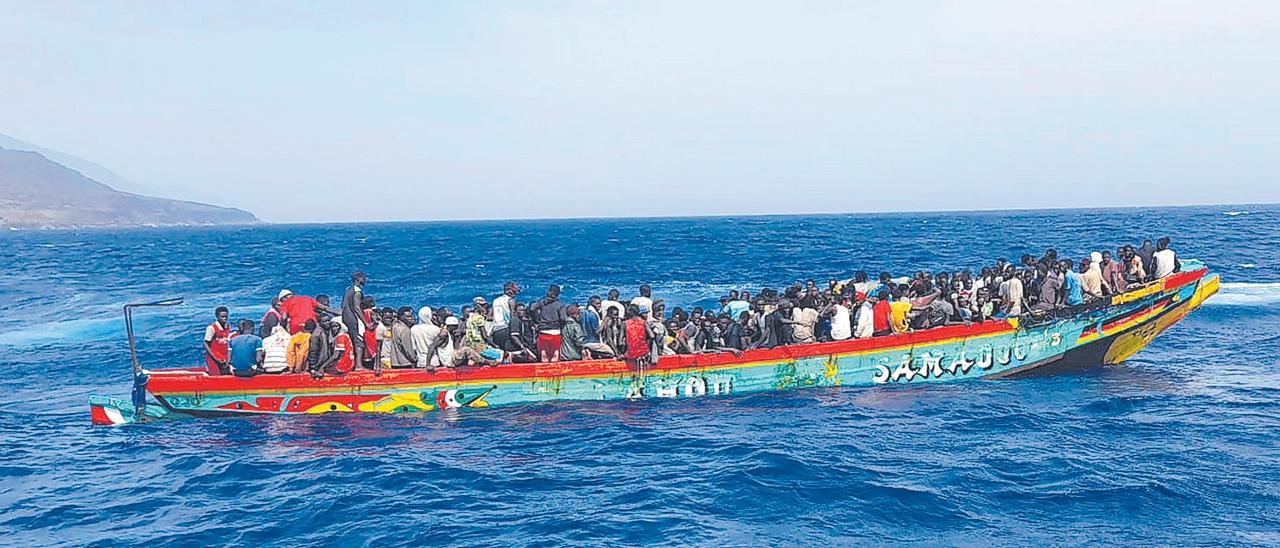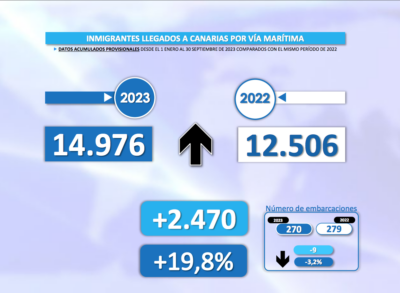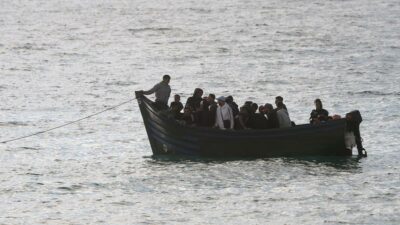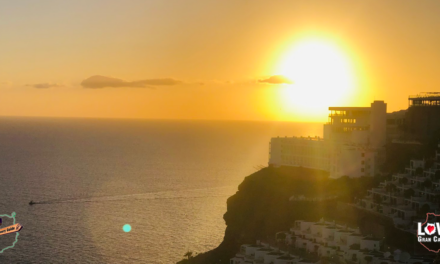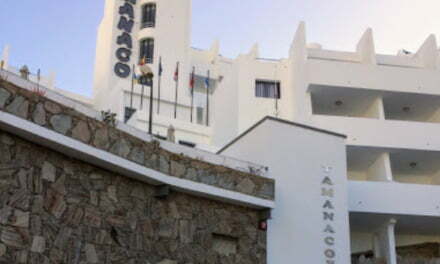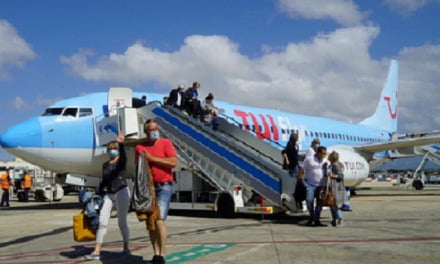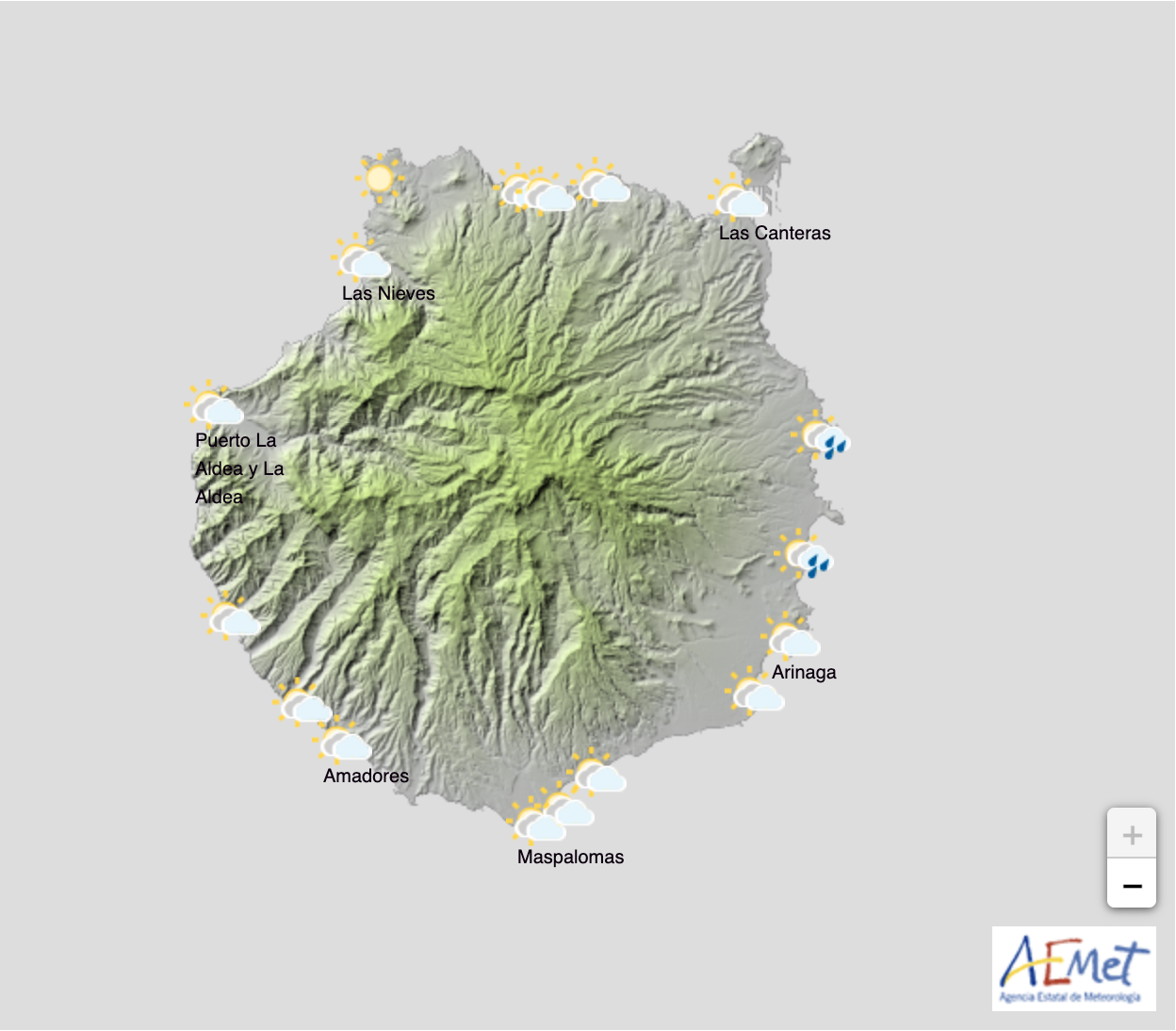The Canary Islands have seen a near 20% increase in migrant arrivals by boat during the first nine months of 2023 compared to the same period in 2022, according to the latest data from the Ministry of the Interior. Despite this rise in migrants, the number of boats arriving has actually decreased by 3.2%, from 279 last year to 270 so far this year.
A Surge in Cayucos
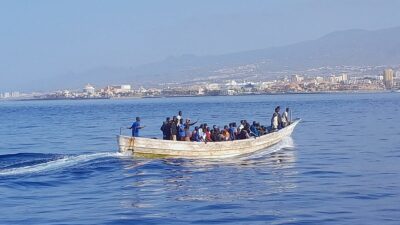 The increased number of migrants correlates with the growing presence of “cayucos”, large fishing boats capable of carrying between 100 and 200 people, particularly noted since this summer. These boats have been especially active along the Canary Route, resulting in a significant number of arrivals to the smaller islands of the archipelago, such as El Hierro.
The increased number of migrants correlates with the growing presence of “cayucos”, large fishing boats capable of carrying between 100 and 200 people, particularly noted since this summer. These boats have been especially active along the Canary Route, resulting in a significant number of arrivals to the smaller islands of the archipelago, such as El Hierro.
Wider Context in Spain
Nationwide in Spain, migrant arrivals increased by 20% compared to the same period in 2022, with a total of 26,540 irregular entries by both sea and land. Interestingly, the rate of arrivals has slowed as summer came to an end.
Local services in the Canary Islands are being increasingly strained due to the spike in arrivals. The port of La Restinga in El Hierro received a cayuco with a record-breaking 280 migrants on board. The continuous arrival of boats to El Hierro has overwhelmed local healthcare resources, costing an extra €102,000 in healthcare services in just the month of August, on this small island with a resident population of just over 11,000 people.
Government Response
In response to the crisis, Canary Islands’ Vice President Manuel Domínguez has called for the issue to be treated as a “State matter,” urging the central government in Madrid to take action. The Canary Islands have also declared a social emergency to expedite processes and secure resources for unaccompanied minors. The Canary Islands currently have more than 2,900 minors under their care, a number that has been growing steadily since 2019.
The local government is taking steps to increase accommodations, with plans to tender over 1,000 new places. Meanwhile, the El Hierro Island Cabildo is unanimously calling for the central government to increase resources for the Red Cross, Civil Protection, National Police, and others involved in the reception and care of migrants.
International Involvement
El Hierro’s Island Council also seeks involvement from European Union representatives and Spanish ministers in a summit to discuss concrete measures related to hospitality infrastructure, healthcare, security, and humanitarian assistance.
The continuous flow of migrants presents a mounting challenge not only for the Canary Islands but also for Spain as a whole, requiring immediate attention and collaborative action from local, national, and potentially international bodies.
Spanish State’s Response Criticised
The surge in migrant arrivals has seen more than 1,500 individuals headed for The Canary Islands intercepted by Maritime Rescue since just last Wednesday. The latest count includes 259 people who were aboard two boats approaching Gran Canaria and Tenerife.
Regional Government’s Grievances
Fernando Clavijo, President of the Canary Islands, has been vocal in his criticism of the Spanish state for its lack of action. Despite the geographical factors that inherently make the Canary Islands a focal point for migration, the regional government feels that the state has been indifferent in addressing the crisis. Clavijo reiterated these concerns in a recent meeting with Teresa Ribera, Spain’s Minister for Ecological Transition, having also previously voiced them to the King and Spain’s Ministry of The Interior.
Increasing Numbers
According to the Spanish Ministry of the Interior, as of September 30, 14,976 people have arrived on the islands irregularly, marking a 19.8% increase compared to the same period last year. If the current trend continues, experts warn that the number will likely surpass the 15,682 migrants recorded last year.
El Hierro: The Hardest-Hit Island
El Hierro has been particularly affected, receiving more than 4,000 arrivals since June, without the adequate resources to address the needs of these individuals. The regional Vice President, Manuel Domínguez, visited the island to understand the challenges faced by its residents.
The Inadequacy of Plan Canarias
The “Plan Canarias,” activated after the situation that arose during the pandemic at the Arguineguín pier, outlines a protocol for transferring migrants to the mainland. However, it falls short of addressing mass arrivals. Clavijo warned that this could not only overwhelm the facilities in the archipelago but also fuel xenophobic rhetoric, as was seen in 2020 and 2021.
Maritime Rescue on Alert
Maritime Rescue has issued an alert regarding the approach of two more boats carrying around 200 people towards El Hierro and Tenerife. Meanwhile, boats carrying 82 and 74 sub-Saharan males arrived at Punta Rasca and Gran Canaria, respectively. Another boat with 103 sub-Saharans was escorted to La Restinga, including 93 males, seven females, and three minors.
As authorities brace for more arrivals, the demand for a more comprehensive and coordinated response from the Spanish state continues to intensify.

